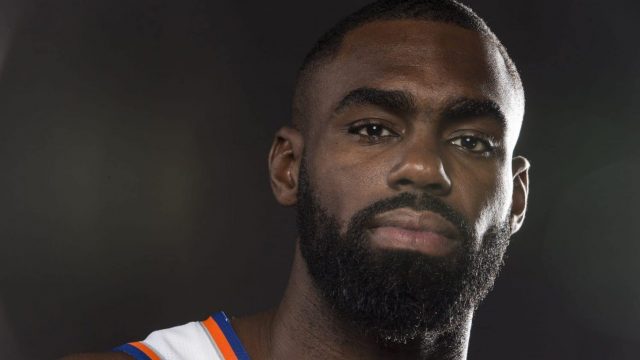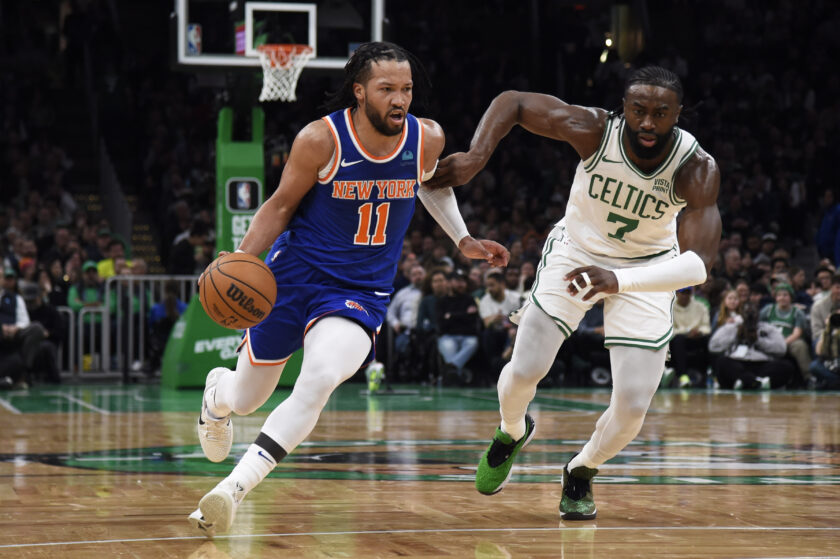New York Knicks: Tim Hardaway Jr. will be a cheaper, more productive Andrew Wiggins

Tim Hardaway Jr. is trending towards becoming one of the bright, young shooting guards of the NBA. A comparison with Andrew Wiggins shows that the New York Knicks may truly have one of their core players for years to come.
Flashback to the summer of 2017, the New York Knicks first big free-agent signing of the summer was not exactly receiving rave reviews. Originally drafted by the Knicks in 2013, Tim Hardaway Jr. was returning to New York after signing a four-year, $70 million contract.
Yaron Weitzman of Bleacher Report wrote that executives were calling the Knicks “Nuts.” Even Adam Schefter of ESPN, who doesn’t cover the NBA, chimed in:
In his 14-year, 5-time-NBA-all star career, Tim Hardaway Sr. earned $47.1 million. Tim Hardaway Jr. will make $71M the next four years.
— Adam Schefter (@AdamSchefter) July 7, 2017
However, a comparison between two young and up-and-coming shooting guards including Hardaway Jr. and Wiggins shows Knicks fans why there is plenty to be excited about despite Hardaway’s expensive contract.
To be fair, Wiggins has had much higher expectations placed on him in comparison with Hardaway Jr. Drafted number one by the Cleveland Cavaliers during the 2014 draft, Wiggins has been trying to live up to star expectations since being traded to the Minnesota Timberwolves.
Wiggins’ game is also different from Hardaway Jr.’s as Wiggins is more of a slasher who prefers to take players on the perimeter and drive to the hoop. He’s more of a high-flyer, although Hardaway Jr. is no slouch in this area.
The offensive numbers for both Hardaway Jr. and Wiggins are quite similar. Wiggins owns the edge is scoring averaging 17.7 points per game, compared to Hardaway Jr.’s 16.8 points per game.
Additionally, while Hardaway Jr. has a reputation as being a better shooter, both his field goal percentage 41 percent, and three-point percentage 31 percent is lower than Wiggins’ who currently shoots 44 percent from the field and 32 percent from three-point range.
Hardaway Jr. leads Wiggins in free-throw percentage at 79 percent compared to 63 percent. He also averages more assists per game at 2.9 compared to Wiggins’ 1.8, yet no one will confuse either player for John Stockton.
https://www.youtube.com/watch?v=h6MQ7aZKioM
Outside of traditional statistics, the advanced analytics tend to favor Hardaway Jr. “Shimmy” is ahead in Offensive Box Plus/Minus 1.7, Defensive Box Plus/Minus -1.4, and Box Plus/Minus 0.3. Wiggins’ although not far behind, trails in all categories, Offensive Box Plus/Minus -1.1, Defensive Box Plus/Minus -1.6, and Box Plus/Minus -2.7.
Furthermore, per 36 minutes statistics show that Hardaway Jr. would be estimated to average 18.6 points per game whereas Wiggins would average 17.7 points per game. Per 100 possessions, Hardaway Jr.’s Offensive Rating is also slightly higher (105) than Wiggins’ (102).
One caveat with these statistics is games played. To date, Wiggins has played in all of the Timberwolves’ 64 games compared to Hardaway Jr. who has only played in 40 games. Hardaway Jr. missed a significant amount of time due to a lower-leg stress injury back in December.
[sc name=”Knicks Center”]You can look at this one of two ways. Hardaway Jr.’s numbers are at least somewhat impressive considering he missed almost a quarter of the season. Hardaway Jr. is also missing Kristaps Porzingis; the duo was impressive during the early part of the season.
On the other hand, you can praise Wiggins for his durability. Wiggins has played in at least 81 games during the first three of his four NBA seasons.
In combination with Hardaway Jr.’s potential, his contract is what puts him over the edge in regards to a comparison with Wiggins.
In defense of Hardaway Jr.’s contract, Steve Mills made several points as to why the Knicks were ‘aggressive’ in pursuing the fifth-year pro out of Michigan. Daniel Popper of the New York Daily News quotes Mills as he explains:
“As we look at the numbers, we believe Tim is a starting two guard in this league, our trajectory for him is to be a starting two guard. (He has) the capability of being a starting two guard for the rest of his career. And those guys average 16, 16.5 million dollars in the NBA today.”
Per Spotrac, almost three months later, Wiggins signed a five-year $146 million extension, keeping him with the Timberwolves through the 2022-2023 season.
Starting next season, Wiggins will be making over $25 million per year compared to Hardaway Jr.’s $17 million. Yet, if you look at their production and estimated future production, Hardaway Jr. is the more affordable and productive player.
Unfortunately, the Knicks will enter this off-season, in a familiar position, with numerous questions and holes to fill. Some of the answers may come in the lottery, where the Knicks will likely have a top 10 draft pick for the third time in the last four seasons.
However, if you want a silver-lining, Hardaway Jr. may be it. The sky is the limit for this young player, and if he can stay healthy, he can be a lethal threat from the perimeter. Knicks fans can rest assured that they have their starting two-guard of the future.
[sc name=”Knicks Link Next” link=”https://elitesportsny.com/2018/03/03/new-york-knicks-salary-cap-restriction-could-represent-sneaky-blessing/” text=”Knicks Salary Cap Restriction Could Be A Sneaky Blessing” ]




